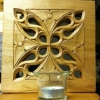Carving the banner scrolls at either end, which are reminiscent of medieval 'linenfold' work.
We also remove the carving from the backing board, 'back off' the outer edges and finish the wood.

| 26 June 2013 07:42
Pete - That's a good point (and absolutely not a criticism!). You are quite right about allowing wood to move. You can see huge numbers of 'applied' carvings glued and pinned on, to fire surrounds and friezes for example, without a problem. I've done it many times myself. I think it's a matter of scale: these small light carvings just don't have the strength to pull away from contrary grain. On the other hand larger carvings, especially panels, need to be treated as you would any woodwork - fielded, say, or given a looser fix as you suggest.

| 23 June 2013 14:14
Hi Chris Great, great series. My only reservation is, as Furniture maker, I was taught never to glue and screw solid timber to a ply or other stable surface as once the wood moves either in shrinkage or swelling it would be likely to either split or burst away from the surface beneath. Have you had this problem? I do appreciate that there has to be some form of fixing. The way I was taught would have meant fixing with screws in slots at right angles to the grain thus allowing for some movement.
I do hope my comment will be taken in the way it is intended, as a new comer to this wonderful series I would hate to seem to be criticising.
Pete The Wood Servant

| 10 July 2012 07:06
Derrick - That's generally true: you don't want to carve through a sanded surface for fear of dulling your cutting edge on residual grit. On this scale, however, I found that having sanded to a fine finish and well-brushed the surface I didn't notice any effect when I did eventually add the names. I think it's better to work on a truly flat surface for lettering. As for time: ('minutes' - I like that!) the leaves, and delta spaces in between, took around 4-5 hours. The trick is getting into a rhythm.

| 10 July 2012 05:15
Chris, if you were going to carve a word into the banner would you wait to sand it after carving or would it make any difference? I think I have heard/read that carving into sanded surfaces dulls your tools but I've not tried it and don't know if its a significant issue. Also, how long would you estimate(in hours or minutes) the leaves part of the carving took you?

| 23 April 2012 13:08
Thank you for a really wonderful project and for demonstrating one particular way to create a beautiful landscape feature for other relief carvings.